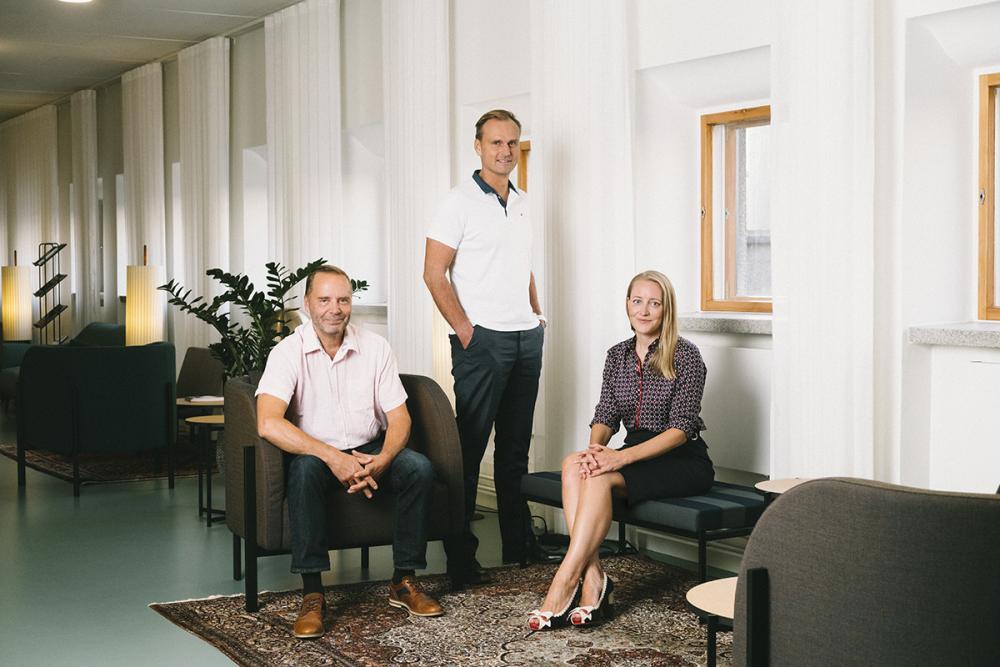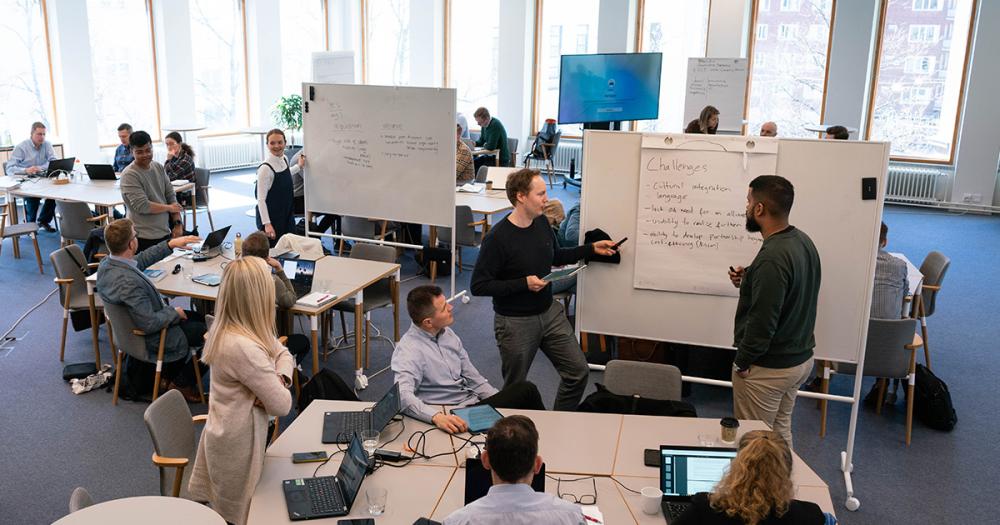While digital transformation has been a buzzword in business for the last couple of years, Gustafsson cautions that many still do not fully appreciate the magnitude of disruption.
“The economics of digital is totally different from the economics of the traditional world,” Gustafsson says.
“Time-honored business theories no longer suffice. 90% of what I teach masters level students at Aalto University has changed during the past five years. If you have graduated over five years ago – as is the case for most leaders – you can be fairly sure you lack in-depth digital and platform business understanding now necessary for strategic decision making. Leaders have two options; they can hire young talent to fill the knowledge gap or they can learn for themselves. I recommend doing both,” he challenges.
A balanced team and small experiments keep you innovative
A central concern for organizations is how to stay innovative in the digital age.
“Research shows that the majority of managers in large, established organizations have trouble staying innovative, particularly when faced with technology disruptions,” points out Katila.
“Many science-based companies face an ‘expertise trap’ where what once made them successful presents a risk in a rapidly changing technology landscape. Deep expertise can cripple an organization and prevent change; instead we encourage using an organization’s underlying strength – such as in engineering – to truly drive innovation,” she advises.
Katila presents two rules of thumb to help an established organization dislodge from its entrenched trajectory of incremental improvements to become more agile and accelerate breakthrough innovation: #1 - Balance your team and #2 - Embrace small experiments.
Experts are invaluable, but so are outsiders who can see business challenges and opportunities with fresh eyes.”
“Experts are invaluable, but so are outsiders who can see business challenges and opportunities with fresh eyes,” Katila reminds.
To succeed in innovation, she advocates building a team of experts from a variety of fields.
“Research we have conducted at Stanford regarding the health sector, for instance, shows that the sweet spot for innovation is when experts make up about 40 percent of an invention team—any less, and the company will lose sight of what its customers need; any more, and the group will tend to converge on old ideas,” she asserts.
Katila recommends that organizations build an entrepreneurial culture where teams feel safe to experiment and learn through experiments in small scale.
“Develop a strategy for your organization that supports experimentation, evidence-based decision-making, and includes steps to harness the power of failure. Everybody likes to plan for success, but also consider key areas in which your team is likely to fail. Help your team of experts to be agile by developing a strategy to fail fast, and learn from it,” she emphasizes.
A homogenous group is your best bet in an innovation network
The digital world order calls for collaboration and coopetition - a portmanteau of cooperation and competition.
Gustafsson calls attention to a simple but crucial criterion of successful innovation networks: while innovation within an organization or sector flourishes when you build a team of experts from a variety of fields, innovation networks stagnate if you include a wide array of organizations with conflicting interests.
“Long term collaborative research and innovation efforts have given us a good idea of the key requirements and common hindrances of invigorating innovation networks. A central issue to keep in mind is that the more heterogenic interests the participants in the innovation network have, the more difficulties will arise. A group with more similar interests makes setting targets easier and coopetition attractive,” he explains.
In a heterogenous group every step of the way will call for compromise, which inevitably dilutes the value the collaboration will bring."
Gustafsson gives practical examples to clarify this notion. An innovation network consisting of for example representatives of energy, environmental and public sector organizations may sound like a splendid idea, but would in fact be far from ideal.
“Setting an agenda, agreeing on common goals and how to advance – every step of the way will call for compromise, which inevitably dilutes the value the collaboration will bring,” he says.
“Pooling the resources of Finnish engineering companies is a good example of a focused innovation network with organizations operating in similar technology environments and facing comparable challenges. It may sound surprising, but with a network like this, competitors can join forces and fairly easily agree on common innovation agenda to find new solutions that benefit them all,” Gustafsson adds.
Learn from startups: be open about what you don’t know and make full use of your talents’ potential
A startup mentality often comes up when discussing current prerequisites to success. Katila describes two key lessons old organizations can learn from startups: #1 Design roles for your best people and #2 Check your bias.
In a startup, an early employee is not just doing one thing. Everyone’s role is broader. Katila affirms that this type of job design is important for large firms as well.
“For example, research shows that if you turn your best creative talent into managers, but do not give them any time to innovate, creativity atrophies. Your creators cannot turn on a high level of creativity, even if they were once brilliant at it, if innovation is not part of their day jobs. Thus, designing the organizational role so that it fully uses the individual’s potential is important,” Katila notes.
Your creators cannot turn on a high level of creativity, even if they were once brilliant at it, if innovation is not part of their day jobs."
Startups have the advantage of starting from a clean slate. In contrast, leaders in big organizations have built years of expertise and intuition about the right decisions.
“For sure, there is no substitute for expertise. But your experience shapes your reactions to change. To stay innovative during the digital evolution, you should learn from startups and build a culture in which you and others are open about what you do not know, not only about what you know,” Katila underlines.
“Our research shows that expert business leaders grow increasingly impatient with potential breakthrough ideas – and increasingly fond of safe ones – as their tenure in the industry sector grows. As an expert, it is important to check your bias and allow data, not only past experiences, to help in decision-making," she adds.
Teaching leadership skills for the digital age
Aalto EE and Stanford Center for Professional Development are collaborating to introduce a novel program, which will provide participants with the leadership skills needed to succeed amidst digital disruption, to execute innovation initiatives, and lead agile organizations.
“The new program is delivered in Palo Alto and in Helsinki and gives participants a chance to compare, contrast, benchmark and strategize with the best minds in Silicon Valley and the Nordics,” Gustafsson describes.
We believe the best way to innovate is to understand the underlying rapidly changing technologies that drive innovation and explore business strategies that guide them."
The program covers relevant technology from AI and software robotics to blockchain, illustrates new business rules of platform economy and boundary resources, compares business strategies of the Big Five – Google, Facebook, Amazon, Apple and Microsoft – explaining why they are so dominant, shows how to leverage teams for global innovation, and teaches innovation strategy, focusing on culture for risk-taking, structures that support innovation, and the upside of competition.
“We believe the best way to innovate is to understand the underlying rapidly changing technologies that drive innovation and explore business strategies that guide them. This program seamlessly blends the best and latest expertise from Stanford and Aalto in the areas of innovation, entrepreneurship and digitalization,” says Katila.
“The four-month program combines online and in-person learning to help participants understand the latest trends in digital technology as well as to teach practical tools and methods for immediate impact back at work,” she concludes.
The Certificate in Digital Business Strategy and Innovation Agility program has been co-created by Aalto EE and the Stanford Center for Professional Development (SCPD) to provide participants with the leadership skills needed to execute innovation initiatives, lead agile organizations and conquer the digital disruption wave. Read more about the program.













